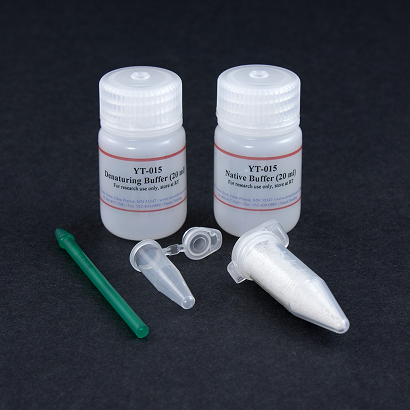Minute™ Total Protein Extraction Kit for Microbes with Thick Cell Walls (50 Preps)
Manual & Protocol (PDF) | Material Safety Data Sheets (MSDS)(PDF)
View All Related Products

Description
Protein extraction from cell-wall-containing microbes is a common procedure. The methods for protein extraction are usually harsh, tedious and unreliable. YT-015 provides an instrument-free, fast and gentle way for extracting proteins from microbes with thick and strong cell walls. These microbes include yeast, filamentous fungus, gram-positive and -negative bacteria, insect eggs, microalgae and more. This kit contains optimized denaturing and native protein extraction buffers to choose from. Unlike many other methods with harsh conditions, such as 8 M urea, glass bead lysis using an instrument and boiling the sample with alkaline extraction, etc., are used for yeast protein extraction. Proteins in certain molecular weight ranges are usually preferentially extracted with these methods. This kit features a single tube protocol and allows for a full range of yeast proteins to be extracted without bias. The kit works well for both log-phase and stationary-phase microbes. The whole procedure takes less than 10 minutes to complete and the protein yield is in the range of 2-5 mg/ml. The materials provided are sufficient for 50 extractions.

Kit Includes
| Items | Quantity | Denaturing Buffer | 20 ml |
| Native Buffer | 20 ml |
| Protein Extraction Powder | 5 grams |
| 1.5 ml Microfuge Tube | 50 units |
| Pestles | 4 units |
References
1. Nagayoshi, Y., Miyazaki, T., Shimamura, S., Nakayama, H., Minematsu, A., Yamauchi, S., ... & Mukae, H. (2017). Unexpected effects of azole transporter inhibitors on antifungal susceptibility in Candida glabrata and other pathogenic Candida species. PloS one, 12(7), e0180990.
2. Al-Omari, A., Griffith, J., Caranica, C., Taha, T., Schuttler, H. B., & Arnold, J. (2018). Discovering regulators in Post-Transcriptional control of the Biological Clock of Neurospora crassa using Variable Topology Ensemble Methods on GPUs. IEEE access.
3. Terashima, M., Ohashi, K., Takasuka, T. E., Kojima, H., & Fukui, M. Antarctic heterotrophic bacterium Hymenobacter nivis P3T displays light‐enhanced growth and expresses putative photoactive proteins. Environmental Microbiology Reports.
4. Lin, W., Yuan, D., Deng, Z., Niu, B., & Chen, Q. The cellular and molecular mechanism of glutaraldehyde‐didecyldimethylammonium bromide as a disinfectant against Candida albicans. Journal of Applied Microbiology.
5. Shimamura, S., Miyazaki, T., Tashiro, M., Takazono, T., Saijo, T., Yamamoto, K., ... & Mukae, H. (2019). Autophagy-Inducing Factor Atg1 Is Required for Virulence in the Pathogenic Fungus Candida glabrata. Frontiers in microbiology, 10.
6. Wang, Y., Ma, Y., Wang, D., Liu, W., Chen, J., Jiang, Y., ... & Qin, L. (2019). Polar tube structure and three polar tube proteins identified from Nosema pernyi. Journal of Invertebrate Pathology, 107272.
Post Reviews
 We're here to help
We're here to help
Get expert recommendations for common problems or connect directly with an on staff expert for technical assistance related to applications, equipment and general product use.
Contact Tech Support
 High Quality Guaranteed Product
High Quality Guaranteed Product
Our products such as Elisa, Antibodies, Proteins, Peptides and sequencing kits are covered by Biolinkk quality warranty and will work as described in datasheet, a free replacement or money back is guaranteed if does not perform according to datasheet.
Learn More


